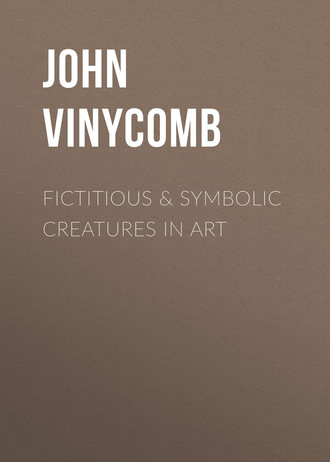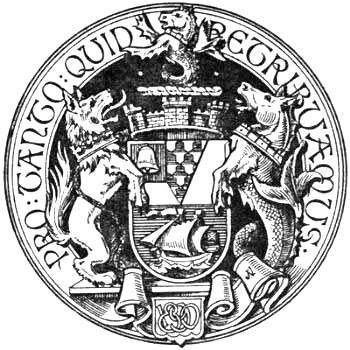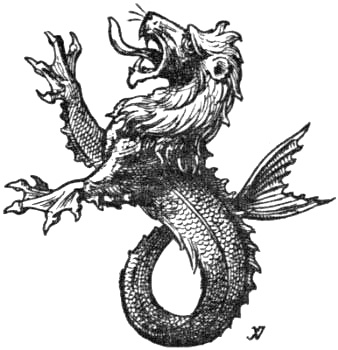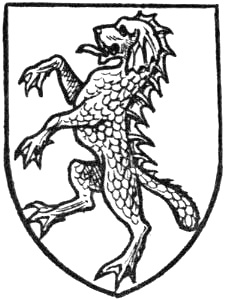 полная версия
полная версияFictitious & Symbolic Creatures in Art
The coast of Naples is celebrated for the production of a small fish in great repute with mothers who nurse their offspring; among its other virtues it is said to cure the bite of a mad dog. It is about four to six inches in length, and has a head resembling that of a horse, terminating in a dragon’s tail. This is the tiny hippocampus of our public aquariums. The Neapolitans call them “cavalli-marini,” which was once ingeniously translated by a learned English traveller as “horse marines.”
This fabulous marine creature in heraldry is compounded of the fore quarters of a horse with webbed paws, and the hinder part of a fish or dolphin. A scalloped fin is continued down the neck and back in place of a mane. It is frequently, though erroneously, to be seen depicted with the flowing mane of a horse; wings are also sometimes added to it, both of which, it is needless to say, are wrong, unless specially mentioned in the blazon.
The Westenras (Baron Rossmore), descended from the family of Van Wassenhaer of Wassenburg, were of great antiquity in Holland, and they bore the augmentation of the sea-horse in reference to the valour and intrepidity of an ancestor, who, during the Duke of Alva’s campaign, was actively employed against the enemies of his country and undertook at great risk to swim across an arm of the sea with important despatches to his besieged countrymen.

Arms of the city of Belfast. The sinister supporter and crest are Sea-horses.
The Sea-horse is of very frequent use in armory, and usually has reference to meritorious actions performed at sea. It is also borne by many seaport towns in allusion to the trade and commerce of the port, as in the arms of the city of Belfast.
Cromwell, Protector, bore as supporters a lion of England and a sea-horse, probably to denote his protectorship of the sea, as of the land.
Bossewell (“Works of Armorie,” 1589), in his peculiar mixture of English and Latin, gives a quaint description of the animal: “This water-horse of the sea is called a hippotame, for that he is like an horse in back, mayne, and neying: rostro resupinato a primis dentibus: cauda tortuosa, ungulis binis. He abideth in the waters on the day, and eateth corn by night et hunc Nilus gignit.” The latter may be classed with those fantastic ornamental forms frequently employed in fountains and waterworks, such as the Ichthyocentaur, i.e., a combination of man and horse, or the centaur with a fish’s extremity.
Sea-lion
or Lion poisson, a mythical sea-creature, frequently used in heraldry as an emblem of bold actions achieved on the ocean in the country’s service. It is depicted as the fore part of a lion with webbed feet, the hinder part ending in a fish’s tail.
Two such animals support the arms of Viscount Falmouth.
The Earl of Howth has for supporters a sea-lion argent, and a mermaid, proper. The crest also is a sea-lion.

Sea-lion erect.
The crest of Duckworth is a tower, the battlements partly demolished, from the top flames issuant proper; on the sinister side a sea-lion erect azure, pressing against the tower.
Silvestre.—Argent, a sea-lion couchant azure, crowned armed and langued gules.
When the sea-lion or other compounded creature of this kind is erect, it should be clearly blazoned as “a sea-lion erect on his tail,” to distinguish it from naiant, the swimming position natural to it.
Sea-dog
is depicted like a talbot in shape, but with the tail like that of a beaver, the feet webbed and the whole body scaled like a fish, a scalloped fin continued along the back from the head to the tail.
Baron Stourton has two such beasts, sable, scaled or, for his supporters.
The crest of Sir H. Delves Broughton.—A sea-dog’s head gules, eared and finned argent.

Sea-dog rampant.
The Sea-bull, Sea-wolf, Sea-bear, Sea-cat, Sea-dragon, etc., when they occur in heraldry, are all depicted as having the anterior portions of their bodies in the forms which their several names denote; but, like the sea-lion and sea-horse, they have fishes tails and webbed paws.
In conclusion, having, as far as possible, given the raison d’être of each, and traced the life-history and characteristics of the many strange and fantastic creatures in our symbolic menagerie, it only remains to express the hope that the information contained in this volume may be found both interesting and useful, as without some such knowledge there can be little or no intelligent understanding of the proper treatment of the forms of these mythical and symbolic beings. The suggestive illustrations, while giving the recognised forms of each, leaves to the artist free scope to adopt his own style of art treatment, whether purely heraldic or merely decorative.
1
“Decorative Heraldry,” by G. W. Eve.
2
The above notes on heraldic treatment are largely adapted from the admirable works on Decorative Art, by Louis F. Day.
3
See Audsley’s “Glossary of Architecture,” “Angel,” p. 101.
4
“Restit. of Decayed Intell. in Antiq.” p. 147.
5
“Great Cities of the Middle Ages.”
6
“History of Signboards.”
7
Brewer’s “Dictionary of Phrase and Fable.”
8
“Analysis of Ornament,” by Ralph N. Wornum.
9
That is, Visconti is only a variation of Biscia equivalent to Anguis, Italianised to Angleria.
10
Pliny, Book xi. ch. 25, from an old translation.
11
But for an oversight in the drawing, the unicorn should have been represented with the divided hoofs of a stag.
12
“Mythology of Greece and Rome, with special reference to its Use in Art,” from the German of O. Seemann.
13
W. N. Humphry’s “Coin Collector’s Manual.”
14
“Modern Painters,” vol. iii. ch. 8.
15
“Historical Devices, Badges, and War Cries,” p. 10.
16
“Iconography of Christian Art.”
17
“Orlando Furioso,” iv. 18, 19.
18
“Manners and Customs of the Ancient Egyptians.”
19
W. Noel Humphry’s “Coin Collector’s Manual.”
20
Book x. ch. 2.
21
Guillam’s “Display of Heraldry.” The same is also related in the Latin “Bestiarium,” Harl. MSS. 4751; and by Albertus Magnus, Camerarius, &c.
22
“Cassell’s Natural History.”
23
Bk. viii. ch. 17.
24
Harl. MSS. 6085.
25
Hist. Dev. 260.
26
“Natural History,” x. 67, xxix. 4.
27
Tylor’s “Primitive Culture.”
28
Armorie of Honour, 62.
29
“Coin Collector’s Manual,” Bohn.
30
Book ix. ch. 13.
31
The sign was also used by printers: John Rastall, brother-in-law to Sir Thomas More, “emprynted in the Cheapesyde at the Sygne of the Mermayde; next to Powlsgate in 1572.” Henry Binnemann, the Queen’s printer, dedicated a work to Sir Thomas Gresham, in 1576, at the sign of the Mermaid, Knightrider Street. A representation of the creature was generally prefixed to his books.—“History of Sign-boards,” p. 227.



